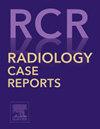伴有骨软骨瘤病的纤维增生性肌病:病例报告
Q4 Medicine
引用次数: 0
摘要
渐进性骨化性纤维增生症(Fibrodysplasia ossificans progressiva)是一种罕见的严重致残性遗传疾病,约每 200 万人中就有 1 人患病。该病的特点是软组织进行性异位骨化,导致骨骼外部位形成异位骨,以及大脚趾先天性畸形。FOP 也可被视为骨软骨生成障碍,大多数肌肉骨骼异常与软骨生成失调有关,如异位软骨内骨化、软骨形成异常、生长板发育不良、骨软骨瘤形成和早期关节病。由于人们往往对这种疾病缺乏认识,导致诊断错误、诊断延误和不必要的干预,有时甚至造成不可逆转的后果。我们报告了一例 2 岁女孩的病例,她没有明显的病史或家族史,表现为双侧拇指外翻,背部和下肢有坚硬的皮下结节。胸腹部和下肢的计算机断层扫描发现了肌肉骨化和骨软骨瘤病,确诊为渐冻人纤维性骨质增生症。本文章由计算机程序翻译,如有差异,请以英文原文为准。
Fibrodysplasia ossificans progressiva associated with osteochondromatosis: A case report
Fibrodysplasia ossificans progressiva is a rare and severely debilitating genetic disorder affecting approximately 1 in 2 million people. It is characterized by progressive heterotopic ossification of soft tissues, leading to the formation of ectopic bone in extraskeletal areas, as well as congenital malformations of the great toes. FOP can also be considered a disorder of osteochondrogenesis, with most musculoskeletal abnormalities related to dysregulated chondrogenesis, such as heterotopic endochondral ossification, abnormal cartilage formation, growth plate dysplasia, osteochondroma formation, and early arthropathy. The frequent lack of awareness of this disease often results in diagnostic errors, delays in diagnosis, and unnecessary interventions, sometimes with irreversible consequences. We report the case of a 2-year-old girl with no significant medical or family history, presenting with bilateral hallux valgus and firm subcutaneous nodules on the back and lower limbs. A thoracoabdominal and lower limb computed tomography scan revealed muscular ossifications and osteochondromatosis, confirming the diagnosis of fibrodysplasia ossificans progressiva.
求助全文
通过发布文献求助,成功后即可免费获取论文全文。
去求助
来源期刊

Radiology Case Reports
Medicine-Radiology, Nuclear Medicine and Imaging
CiteScore
1.10
自引率
0.00%
发文量
1074
审稿时长
30 days
期刊介绍:
The content of this journal is exclusively case reports that feature diagnostic imaging. Categories in which case reports can be placed include the musculoskeletal system, spine, central nervous system, head and neck, cardiovascular, chest, gastrointestinal, genitourinary, multisystem, pediatric, emergency, women''s imaging, oncologic, normal variants, medical devices, foreign bodies, interventional radiology, nuclear medicine, molecular imaging, ultrasonography, imaging artifacts, forensic, anthropological, and medical-legal. Articles must be well-documented and include a review of the appropriate literature.
 求助内容:
求助内容: 应助结果提醒方式:
应助结果提醒方式:


